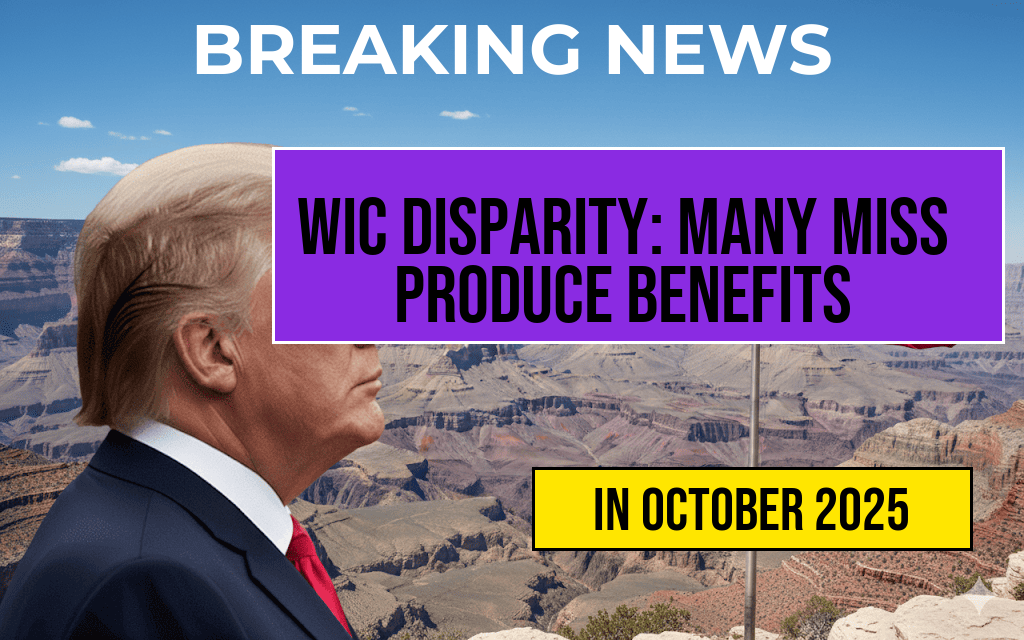WIC Enrollment Disparity: Half of Eligible Families Miss Out on $312 to $936 Annually in Produce Benefits
Millions of low-income families eligible for the Special Supplemental Nutrition Program for Women, Infants, and Children (WIC) are missing out on substantial annual benefits designed to improve nutrition and health outcomes. Recent analyses reveal that nearly 50% of eligible households do not participate, leaving an estimated $312 to $936 annually in potential produce benefits unclaimed per family. This gap underscores ongoing barriers to access, including administrative hurdles, lack of awareness, and limited provider outreach, which disproportionately affect marginalized communities. As policymakers consider expanding nutritional assistance programs, addressing these participation gaps could significantly enhance food security and improve health metrics among vulnerable populations.
Understanding WIC and Its Benefits
The WIC program, administered by the U.S. Department of Agriculture (USDA), primarily targets pregnant women, new mothers, infants, and young children up to age five. Its core goal is to provide nutritious foods, nutrition education, and health referrals to support healthy pregnancies and early childhood development. Participants receive benefits in the form of vouchers or electronic benefits transfer (EBT) cards that can be used to purchase specific food items, including fruits and vegetables.
According to recent data, the average family participating in WIC can receive between $26 and $78 per month in produce benefits, depending on family size and income level. Over a year, this amounts to roughly $312 to $936 in added nutritional support, which can significantly impact a family’s diet quality. However, a significant portion of eligible households do not tap into these benefits, leaving valuable resources on the table.
Extent of the Enrollment Gap
| Population Group | Estimated Eligible Families | Actual WIC Participants | Participation Rate |
|---|---|---|---|
| Low-income pregnant women, infants, and children | Approximately 8 million | about 6 million | 75% |
| Eligible families missing benefits | ~2 million | N/A | ~50% |
Research indicates that nearly half of eligible families are not enrolled in WIC, with the disparity most pronounced among certain demographic groups. Non-participants often cite reasons such as complicated application procedures, lack of transportation, language barriers, and limited awareness of benefits. These obstacles hinder equitable access, especially for families in rural or underserved urban areas.
Impact of Missed Benefits
The financial gap in produce benefits can have tangible nutritional and health consequences. Families missing out could see their annual food budgets reduced by hundreds of dollars, limiting access to fresh fruits and vegetables—key components of a balanced diet. This nutritional deficit can contribute to higher rates of childhood obesity, developmental delays, and chronic illnesses such as diabetes and hypertension later in life.
Studies link increased fruit and vegetable consumption to improved immune function and overall health, which makes the underutilization of WIC benefits a public health concern. With the rising cost of healthy foods, especially produce, the value of these benefits becomes even more critical in supporting vulnerable households.
Addressing Barriers to Enrollment
- Streamlining Application Processes: Several states have begun simplifying enrollment procedures through online portals and automatic eligibility verification. However, inconsistent implementation remains a challenge.
- Enhancing Outreach and Education: Community-based organizations and healthcare providers play a vital role in raising awareness about WIC benefits and eligibility criteria.
- Removing Administrative Hurdles: Policies aimed at reducing paperwork, providing transportation assistance, and offering multilingual support can improve access, especially among immigrant and minority populations.
Policy Initiatives and Future Directions
Recent proposals advocate for expanding WIC benefits to include broader food options and increased benefit amounts. Some states have piloted programs that automatically enroll eligible families based on Medicaid or SNAP data, minimizing the need for separate applications. Additionally, Congress is debating measures to extend the duration of benefits and incorporate more flexible purchasing options, including online shopping and delivery services.
Experts emphasize that increasing enrollment is a critical step toward reducing disparities and improving population health. Better outreach, combined with policy reforms, could bridge the current gap, ensuring more families receive their rightful share of nutritional support.
Resources and Further Reading
- Wikipedia: Women, Infants, and Children (WIC)
- USDA WIC Program Overview
- CDC on WIC and Child Nutrition
Frequently Asked Questions
What is the main issue discussed in the article?
The article highlights a disparity in WIC enrollment that causes nearly half of eligible families to miss out on annual produce benefits ranging from $312 to $936.
Who is affected by the WIC enrollment disparity?
Eligible families who qualify for the WIC program are affected, with many not enrolling and therefore losing access to valuable produce benefits.
How much money are families missing out on annually due to this disparity?
Families are missing out on between $312 to $936 each year in produce benefits because they are not enrolled in the WIC program.
What are the potential reasons for families not enrolling in WIC?
Barriers such as lack of awareness, complex enrollment processes, or limited access to information may prevent eligible families from enrolling in WIC and receiving produce benefits.
How can the participation in WIC be increased to reduce this disparity?
Strategies like public awareness campaigns, simplifying the enrollment process, and improving access to information can help increase WIC participation and ensure eligible families receive their benefits.










